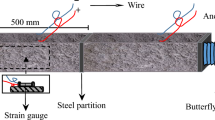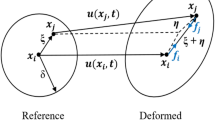Abstract
In this paper, a new forging system was developed and a new complex methodology was tested for the analysis of the closure of voids. The effective geometric shapes of anvils and optimal the forging parameters has been determined. A new cogging process provided a complete closure of voids, which was confirmed by experimental tests. The effect of the reduction ratio, original anvil shape, forging ratio and the location and size of introduced voids on the efficiency of void closure during the multi-transition cogging process was assessed. Moreover, the following were used for the evaluation of void closure: the hydrostatic stress around voids, stress triaxiality, effective strain around voids, and the critical reduction ratio. Numerical examinations were performed using the finite element method (FEM) for the three-dimensional forging process at elevated temperature. Computer simulations of the cogging process under investigation were carried out using a program DEFORM-3D, and selected simulation results were compared with experimental test results. Void reduction predictions obtained from the FEM analysis were in good agreement with the experimental findings. The test results are supplemented with the prediction of crack formation in the zone of existing voids and within the forging volume during the multi-transition cogging process.
















Similar content being viewed by others
Abbreviations
- \(\overline{\varepsilon }\) :
-
Effective strain
- \({\overline{\varepsilon }}_{f}\) :
-
The effective strain at fracture
- \(\dot{\varepsilon }\) :
-
The strain rates
- \({\varepsilon }_{h}\) :
-
Reduction ratio
- \({\varepsilon }_{c}\) :
-
Total reduction ratio
- \(\tilde{\sigma }\) :
-
Effective stress
- \({\sigma }_{m}\) :
-
Mean stress
- \(\eta\) :
-
Stress triaxiality
- \({\eta }_{d}\) :
-
The relative void diameter ratio
- \({\eta }_{V}\) :
-
The relative void volume evolution ratio
- \({\psi }_{CL}\) :
-
Normalized Cockcroft and Latham criterion
- C CL :
-
The critical value of material cracking
- \({l}_{w}\) :
-
Feed rate
- \({H}_{0}\) :
-
Initial height of workpiece
- \({D}_{0}\) :
-
Initial diameter of workpiece
- K:
-
Forging ratio
- Q:
-
The internal void closure evaluation index
References
Lin YC, Liu YX, Liu G et al (2015) Prediction of Ductile Fracture Behaviors for 42CrMo Steel at Elevated Temperatures. J Mater Eng Perform 24:221–228. https://doi.org/10.1007/S11665-014-1273-4/TABLES/4
Cao TS, Mazière M, Danas K, Besson J (2015) A model for ductile damage prediction at low stress triaxialities incorporating void shape change and void rotation. Int J Solids Struct 63:240–263. https://doi.org/10.1016/J.IJSOLSTR.2015.03.003
Chun MS, Van Tyne CJ, Moon YH (2006) FEM analysis of void closure behaviour during open die forging of rectangular billets. Steel Res Int 77:116–121. https://doi.org/10.1002/SRIN.200606363
Zhang XX, Cui ZS, Chen W, Li Y (2009) A criterion for void closure in large ingots during hot forging. J Mater Process Technol 209:1950–1959. https://doi.org/10.1016/J.JMATPROTEC.2008.04.051
Wang B, Zhang J, Xiao C et al (2015) Analysis of the evolution behavior of voids during the hot rolling process of medium plates. J Mater Process Technol 221:121–127. https://doi.org/10.1016/J.JMATPROTEC.2015.02.012
Lee YS, Lee SU, Van Tyne CJ et al (2011) Internal void closure during the forging of large cast ingots using a simulation approach. J Mater Process Technol 211:1136–1145. https://doi.org/10.1016/J.JMATPROTEC.2011.01.017
Kakimoto H, Arikawa T, Takahashi Y et al (2010) Development of forging process design to close internal voids. J Mater Process Technol 210:415–422. https://doi.org/10.1016/J.JMATPROTEC.2009.09.022
Chen MS, Lin YC (2013) Numerical simulation and experimental verification of void evolution inside large forgings during hot working. Int J Plast 49:53–70. https://doi.org/10.1016/J.IJPLAS.2013.02.017
Kim Y, Cho J, Bae W (2011) Efficient forging process to improve the closing effect of the inner void on an ultra-large ingot. J Mater Process Technol 211:1005–1013. https://doi.org/10.1016/J.JMATPROTEC.2011.01.001
Chen K, Yang Y, Shao G, Liu K (2012) Strain function analysis method for void closure in the forging process of the large-sized steel ingot. Comput Mater Sci 51:72–77. https://doi.org/10.1016/J.COMMATSCI.2011.07.011
Chen MS, Lin YC, Chen KH (2014) Evolution of elliptic-cylindrical and circular-cylindrical voids inside power-law viscous solids. Int J Plast 53:206–227. https://doi.org/10.1016/J.IJPLAS.2013.08.005
Saby M, Bernacki M, Roux E, Bouchard PO (2013) Three-dimensional analysis of real void closure at the meso-scale during hot metal forming processes. Comput Mater Sci 77:194–201. https://doi.org/10.1016/J.COMMATSCI.2013.05.002
Chen K, Liu K, Chen H, Yang Y (2014) A criterion for void closure in the porous model during the forging of steel ingot and its application. Comput Mater Sci 91:303–309. https://doi.org/10.1016/J.COMMATSCI.2014.04.056
Feng C, Cui Z (2015) A 3-D model for void evolution in viscous materials under large compressive deformation. Int J Plast 74:192–212. https://doi.org/10.1016/J.IJPLAS.2015.06.012
Feng C, Cui Z, Liu M et al (2016) Investigation on the void closure efficiency in cogging processes of the large ingot by using a 3-D void evolution model. J Mater Process Technol 237:371–385. https://doi.org/10.1016/j.jmatprotec.2016.06.030
Christiansen P, Hattel JH, Bay N, Martins PAF (2014) Physical modeling and numerical simulation of V-die forging ingot with central void: 101177/0954406213517878 228:2347–2356. https://doi.org/10.1177/0954406213517878
Xin R, Ma Q, Li W (2016) Microstructure and mechanical properties of internal crack healing in a low carbon steel. Mater Sci Eng A 662:65–71. https://doi.org/10.1016/J.MSEA.2016.03.045
Carlton HD, Haboub A, Gallegos GF et al (2016) Damage evolution and failure mechanisms in additively manufactured stainless steel. Mater Sci Eng A 651:406–414. https://doi.org/10.1016/J.MSEA.2015.10.073
Geisler A, Sadeghifar M, Morin JB et al (2023) Void closure during open die forging of large size martensitic stainless-steel ingots: an experimental-analytical-numerical study. Int J Mater Form 16:1–11. https://doi.org/10.1007/S12289-022-01735-Y/FIGURES/9
Kukuryk M (2015) Analysis of deformation and microstructural evolution in the hot forgingof the Ti-6Al-4V alloy. Arch Metall Mater 60:1639–1647. https://doi.org/10.1515/AMM-2015-0286
Zhang L, Shen W, Zhang C et al (2017) Numerical simulation of different types of voids closure in large continuous casting billet during multi-pass stretching process. Procedia Eng 207:532–537. https://doi.org/10.1016/J.PROENG.2017.10.817
Acknowledgements
This research was funded by Polish Ministry of Science and Higher Education core funding for statutory R&D activities
Author information
Authors and Affiliations
Corresponding author
Ethics declarations
Conflicts of interest
The author have no competing interests to declare that are relevant to the content of this article.
Additional information
Publisher's Note
Springer Nature remains neutral with regard to jurisdictional claims in published maps and institutional affiliations.
Rights and permissions
Springer Nature or its licensor (e.g. a society or other partner) holds exclusive rights to this article under a publishing agreement with the author(s) or other rightsholder(s); author self-archiving of the accepted manuscript version of this article is solely governed by the terms of such publishing agreement and applicable law.
About this article
Cite this article
Kukuryk, M. Experimental and numerical study of the closure of voids with different size and various locations in the three-dimensional cogging process. Int J Mater Form 17, 3 (2024). https://doi.org/10.1007/s12289-023-01798-5
Received:
Accepted:
Published:
DOI: https://doi.org/10.1007/s12289-023-01798-5




